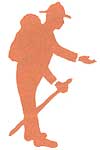|
DELAWARE WATER GAP
Discovering Delaware Water Gap: A Field Book for Young Naturalists |

|
How Do I Relate?
Planners predict that eventually up to 150,000 persons a day will visit the national recreation area. Each will have an impact on the land and water communities. We will walk the trails, drive the roads, boat on the river, explore the forest, have a picnic, and so on. Some of us will bring paper, glass, plastic, metals, and camera film—things that are not of nature—into this natural setting. Each of us can cause some pollution of the land, air, water, and natural beauty, and we can diminish the very solitude we seek. Most of our impact will be unintentional; few people purposefully break limbs, chop trees, vandalize visitor facilities, scatter litter, or break glass bottles. Can the recreation area withstand this growing pressure and survive intact?
The damage we do here is often the result of not thinking. Have you ever asked yourself if pulling up a green plant is a good thing to do? Our attitudes are important. What attitudes do you bring with you?
Do you feel that these scarce habitats and life communities should be treated with reverence and special care? Or do you assume that whatever you do at home or at school you are free to do here, too? (Will your parent or school custodian sweep up litter that you leave along the trail?)
Or do you believe that "anything goes," that out here you are free to abuse, remove, or destroy, as long as no one catches you? Of course, this attitude would ruin what you came to enjoy.
Remember: freedom to play is not freedom to ruin. Out here, for your survival and for the survival of this environment, you need to think about what you do.

Further Explorations: (Choose A Compatible Activity) During your visit to Delaware Water Gap National Recreation Area, you can choose from among many kinds of recreational activity that will help you to relate to nature and that are compatible with the environment. Here are some examples: canoeing, swimming, hiking, picnicking, bicycling, visiting historic sites, attending naturalist programs, fishing, ski touring, and snowshoeing. Not to be ignored is the art of communing with or getting to know nature by just being quiet and letting it "soak" into your deepest self. |
You may find that getting to know the recreation area takes more than a hurried visit. To catch the true spirit of the land, spend time here in different activities and in more than one season. The Lenape lived their entire lives here, so they knew the spirit well. You may want to get close to the land as they did. Take a whole summer's day and float down the river in a canoe. Or follow the trails of Kittatiny Mountain when autumn foliage sets the hillsides afire with color. Come back after a heavy snowfall and track the footprints of deer, fox, and mice across the old fields. Observe the brightly colored birds migrating north in spring, as rains fill the ravines with thundering waterfalls. Or sit quietly on the river shore by moonlight, listening for owls. Get to know the national recreation area on very personal terms. Then you will soon feel the spirit of the land flowing into you.

| <<< Previous | Next >>> |
dewa/handbook/sec4.htm
Last Updated: 30-Apr-2010